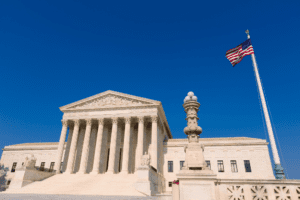 Justice Breyer continued: The right codified by the Second Amendment was “‘inherited from our English ancestors.’” Heller, 554 U. S., at 599 (quoting Robertson v. Baldwin, 165 U. S. 275, 281 (1897)); see also ante, at 30 (majority opinion). And some of England’s earliest laws regulating the public carriage of weapons were precursors of similar American laws enacted roughly contemporaneously with the ratification of the Second Amendment. See infra, at 40–42. I therefore begin, as the Court does, ante, at 30–31, with the English ancestors of New York’s laws regulating public carriage of firearms.
Justice Breyer continued: The right codified by the Second Amendment was “‘inherited from our English ancestors.’” Heller, 554 U. S., at 599 (quoting Robertson v. Baldwin, 165 U. S. 275, 281 (1897)); see also ante, at 30 (majority opinion). And some of England’s earliest laws regulating the public carriage of weapons were precursors of similar American laws enacted roughly contemporaneously with the ratification of the Second Amendment. See infra, at 40–42. I therefore begin, as the Court does, ante, at 30–31, with the English ancestors of New York’s laws regulating public carriage of firearms.
The relevant English history begins in the late-13th and early-14th centuries, when Edward I and Edward II issued a series of orders to local sheriffs that prohibited any person from “going armed.” See 4 Calendar of the Close Rolls, Edward I, 1296–1302, p. 318 (Sept. 15, 1299) (1906); id., at 588 (July 16, 1302); 5 id., Edward I, 1302–1307, at 210 (June 10, 1304) (1908); id., Edward II, 1307–1313, at 52 (Feb. 9, 1308) (1892); id., at 257 (Apr. 9, 1310); id., at 553 (Oct. 12, 1312); id., Edward II, 1323–1327, at 560 (Apr. 28, 1326) (1898); 1 Calendar of Plea and Memoranda Rolls of the City of London, 1323–1364, p. 15 (Nov. 1326) (A. Thomas ed. 1926). Violators were subject to punishment, including “forfeiture of life and limb.” See, e.g., 4 Calendar of the Close Rolls, Edward I, 1296–1302, at 318 (Sept. 15, 1299) (1906).
Many of these royal edicts contained exemptions for persons who had obtained “the king’s special licence.” See ibid.; 5 id., Edward I, 1302–1307, at 210 (June 10, 1304); id., Edward II, 1307–1313, at 553 (Oct. 12, 1312); id., Edward II, 1323–1327, at 560 (Apr. 28, 1326). Like New York’s law, these early edicts prohibited public carriage absent special governmental permission and enforced that prohibition on pain of punishment. The Court seems to suggest that these early regulations are irrelevant because they were enacted during a time of “turmoil” when “malefactors . . . harried the country, committing assaults and murders.” Ante, at 31 (internal quotation marks omitted). But it would seem to me that what the Court characterizes as a “right of armed self-defense” would be more, rather than less, necessary during a time of “turmoil.” Ante, at 20.
A better point for the majority would be that the English King’s oppressive laws were what prompted the founding of our country. Americans should look to the King for how not to govern as opposed to how to interpret our Second Amendment rights.
